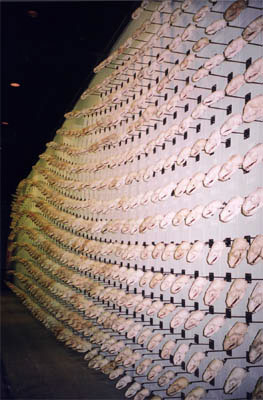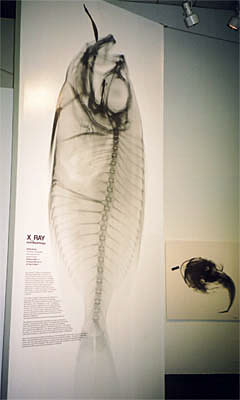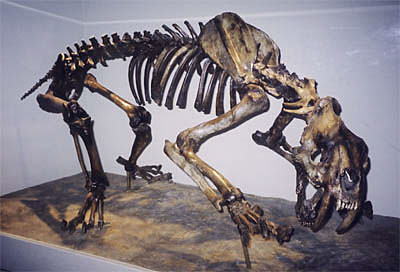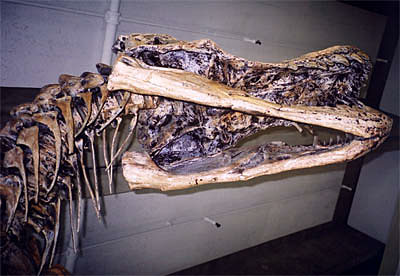Skulls
exhibition and more at the Californian Academy of Sciences

Our excursion out to the Academy was an eventful trip fraught with
traveler
mishaps and frustration. We basically
blundered our way to it, eventually, following several kilometers
of aimless wandering caused by getting off the bus too
early. We were very turned around and a bit rudderless, needless to
say we had very little trouble getting back as we'd
worked everything out that we'd done wrong by then. Still, when you
do stuff up in your travels like this you get to see
much more than anticipated. We ended up at the bottom of the huge
Golden Gate Park, formerly 7miles of sand dunes
and converted over many years into beautiful forest and park land.
At
one point
we walked through an area filled
with
the fragrance of lemon
scented gums and were immediately reminded of home.
The
Academy houses several exhibits of note along with much much more
but I will touch on the three exhibitions
that
really
were outstanding for me.
"Dinosaurs"
A huge dinosaur display consists mostly of true fossils plus some
casts that augmented interpretation.
Fun and instructive
interactions made
for enjoyable viewing; of the exhibits, and the smaller visitors:
these interactives ranged from making a dinosaur
roar to comparative measurements of foot prints. Several complete
dinosaurs assisted in describing the palaeontological record.
A significant experience was delivered by the fact that the display
was substantial and the fossils were real. Children were
asking "..is this really real?" of the bones and happily
the adults in company could confirm this was the case.
"Skulls"
One of the best small thematic exhibitions I've seen in a long time.
The curators and designers got it right with the materials
and budget they had. One wall, see the image below left, was a mass
of Sea lion skulls displayed in a wave pattern.
The effect was amazing and a quiz asked viewers to pick out the "odd"
skulls, 4 "Snow Wolf" skulls were
hiding within
the wave and a visual task asked that you pick them out and describe
how they actually differed from the Sea Lion skulls.
A text panel explained the question many viewers may ask.."Why
so many Sea Lion skulls anyway?", basically the decision
by the Academy or any institution to collect such a large number of
the same variety of specimen is to indeed reveal the
the evolutionary record of such a species and from that record, attributable
effects upon all life. With a major part of the
Sea Lion skull collection on display the argument
for substantial collection is clear, though with this the realisation
that in merely studying a creature
man can contribute quite significantly to diminishing its population.
Lucky (or unluckily)
for Sea Lions they are still plentiful.
On an opposing wall horned skulled creatures came into the picture
with dramatic effect.
The entry wall demonstrated
how humans have included skulls in their arts and folk lore throughout
pre history and history.
The many cases in the middle covered species and interspecial contrasts
with skull development, including a fine selection of
hominid skulls.
A simply gorgeous photographic catalogue accompanied this exhibition
launched during the Halloween holiday
period for maximum effect.
"X-Ray Ichthyology"
Another equally noteworthy exhibition is that concerned with the display
in exhibition of x-ray's used primarily for the interpretation
of Ichthyology specimens. A large elephant's skull is too displayed
to offer a terrestrial contrast of great beauty. Back lit perspex
panels
surround the viewer with a result that arguably eclipses the efforts
of most art installation artists. The effect is such that the viewer
understands
how
dedicated scientific study and fine art can be one and the same thing.
I could not see a catalogue on this one but will keep checking
the website to find out more.
http://www.calacademy.org
The Academy is also the home to The Foucault Pendulum
invented by physicist, Jean Bernard Foucault to describe the earth's
rotation -
"Although the pendulum seems to change its path during the day,
it is actually the floor beneath it that is moving." Yet another
example
of where science meets art. The Academy is well worth any efforts
expended to visit. It is a repository where the muses do live.

image
© lee-anne raymond |
 image
© lee-anne raymond
image
© lee-anne raymond |
 image
© lee-anne raymond
image
© lee-anne raymond |
 image
© lee-anne raymond
image
© lee-anne raymond |
 image
© lee-anne raymond
image
© lee-anne raymond |
 image
© lee-anne raymond
image
© lee-anne raymond |
 image
© lee-anne raymond
image
© lee-anne raymond |







